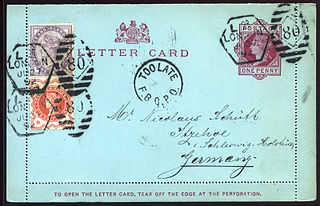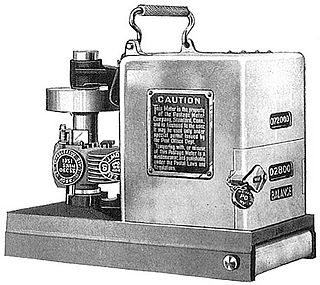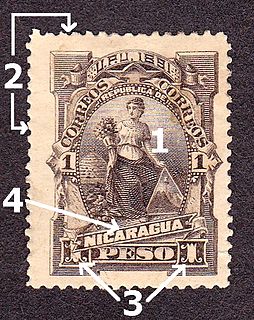
A postmark is a postal marking made on a letter, package, postcard or the like indicating the date and time that the item was delivered into the care of the postal service. Modern postmarks are often applied simultaneously with the cancellation or killer that marks the postage stamp(s) as having been used, and the two terms are often used interchangeably, if incorrectly. Postmarks may be applied by hand or by machines, using methods such as rollers or inkjets, while digital postmarks are a recent innovation. The local post Hawai'i Post had a rubber-stamp postmark, parts of which were hand-painted. At Hideaway Island, Vanuatu, the Underwater Post Office has an embossed postmark.
A first day of issue cover or first day cover (FDC) is a postage stamp on a cover, postal card or stamped envelope franked on the first day the issue is authorized for use within the country or territory of the stamp-issuing authority. Sometimes the issue is made from a temporary or permanent foreign or overseas office. Covers that are postmarked at sea or their next port of call will carry a Paquebot postmark. There will usually be a first day of issue postmark, frequently a pictorial cancellation, indicating the city and date where the item was first issued, and "first day of issue" is often used to refer to this postmark. Depending on the policy of the nation issuing the stamp, official first day postmarks may sometimes be applied to covers weeks or months after the date indicated.

An overprint is an additional layer of text or graphics added to the face of a postage stamp, banknote or postal stationery after it has been printed. Post offices most often use overprints for internal administrative purposes such as accounting but they are also employed in public mail. The most well-recognized varieties are commemorative overprints which are produced for their public appeal and command significant interest in the field of philately.

A piece of postal stationery is a stationery item, such as a stamped envelope, letter sheet, postal card, lettercard, aerogram or wrapper, with an imprinted stamp or inscription indicating that a specific rate of postage or related service has been prepaid. It does not, however, include any postcard without a pre-printed stamp.
The Private Express Statutes (PES) are a group of United States federal civil and criminal laws placing various restrictions on the carriage and delivery of letters by all organizations other than the United States Postal Service.

Postal history is the study of postal systems and how they operate and, or, the study of the use of postage stamps and covers and associated postal artifacts illustrating historical episodes in the development of postal systems. The term is attributed to Robson Lowe, a professional philatelist, stamp dealer and stamp auctioneer, who made the first organised study of the subject in the 1930s and described philatelists as "students of science", but postal historians as "students of humanity". More precisely, philatelists describe postal history as the study of rates, routes, markings, and means.

The French post offices in China were among the post offices maintained by foreign powers in China from the mid-19th century until 1922. The first French Post Office in China opened in 1862. Initially, the French government used ordinary French postage stamps for these offices. These forerunner stamps can be shown to have been sold or used in China only by a postmark. Stamps used at Shanghai prior to 1876, for example, can only be identified by diamond-shaped cancel made of a type referred to as a “losange à gros chiffres” with the numbers "5104" in the center of the cancel.
This is a list of philatelic topics.

Postage stamps and postal history of Great Britain surveys postal history from the United Kingdom and the postage stamps issued by that country and its various historical territories until the present day.

Zeppelin mail was mail carried on zeppelins, the German airships that saw civilian use from 1908 to 1939. Almost every zeppelin flight carried mail, sometimes in large quantities; the covers usually received special postmarks, and a number of nations issued postage stamps specifically intended for use on mail carried by the zeppelins.

Bullseye, in philately, also called Socked on the nose, arefers to a cancellation of a postage stamp in which the postmark, typically a circle with the date and town name where mailed, has been applied centered on the stamp. The ideal bullseye has the entire postmark inside the margins, although this is not always possible, because the stamp may be too small or the postmark too large. The colloquial expression "Socked on the nose" does not seem to be used in Europe: the terms Oblitération centrale in French or luxus in German are in common usage.

A philatelic cover is an envelope prepared with a stamp(s) and address and sent through the mail delivery system for the purpose of creating a collectible item. Stamp collectors began to send mail to each other and to themselves early on, and philatelic mail is known from the late 19th century onward. While some collectors specialize in philatelic covers, especially first day covers and cacheted covers, others regard them as contrived objects that are not reflective of real-world usage, and often will pay a higher price for a cover that represents genuine commercial use. However, mail sent by stamp collectors is no less a genuine article of postage than is mail sent with no concern of seeing the mailed item again. Philatelic covers include mail from first airmail flight and first day of stamp issues ceremonies. Over the years there have been numerous Expositions where special postmarks are made and where a post office is set up where mail can be sent from on the given date of the Expo'. Like any other genuine item of mail these covers include postage stamps and postmarks of the time period and were processed and delivered by an official postal system. Often a philatelic cover will have more historical significance than randomly mailed covers as philatelic covers are also often mailed from the location on the date of an important or noteworthy event, like an inauguration or a space launch.

A cancelled to order postage stamp is a stamp the issuing postal service has cancelled, but has not traveled through the post, but instead get handed back to a stamp collector or dealer. They can come from withdrawn stocks of stamps cancelled in sheets and sold as remainders or from new sheets for sale at reduced rates to the stamp trade. Postal services of various countries do this in response to collector demand, or to preclude stamps issued for the collector market being used on mail. Some of the history of CTOs is from stamps being given to collectors on an approval basis, in person or through mailings; the first CTOs began in the late 19th century.
Franking refers to any devices, markings, or combinations thereof ("franks") applied to mails of any class which qualifies them to be postally serviced. Types of franks include uncanceled and precanceled postage stamps, impressions applied via postage meter, official use "Penalty" franks, Business Reply Mail (BRM), and other permit Imprints (Indicia), manuscript and facsimile "franking privilege" signatures, "soldier's mail" markings, and any other forms authorized by the 191 postal administrations that are members of the Universal Postal Union.

The postal history of Portuguese India goes back to the earlier days of the colony. The postal history begins with communication between the Viceroy and the Court at Lisbon soon after the conquest of Old Goa by Afonso de Albuquerque in 1510. Letters, written in triplicate, were carried by separate ships because of the hazards of the voyage. Mail was carried by an overland route, as well. The early communications of Portuguese India had an official character and the correspondence is now to be found in museums and governmental and ecclesiastical archives.

A postage meter or franking machine is a mechanical device used to create and apply physical evidence of postage to mailed matter. Postage meters are regulated by a country's postal authority. A postage meter imprints an amount of postage, functioning as a postage stamp, a cancellation and a dated postmark all in one. The meter stamp serves as proof of payment and eliminates the need for adhesive stamps.
This is a survey of the postage stamps and postal history of Yemen.
















